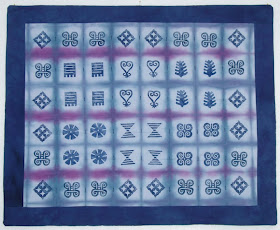
Marshall and Pretty Girl enjoy the warmth of the space heater.
I spent six days in the studio last week after a long hiatus. Ahhhhh! It was wonderful. My routine was disrupted this summer - the unusually high temperatures made the studio unbearable, so I decided to work at home. Of course, it's so easy to be distracted at home. And once the cooler weather arrived, I was so out of the habit of going to the studio, I just never got back to it. I've also been in super-hero procrastinator mode. That, along with a lack of inspiration has led to a pretty long dry spell.
I've learned that there is an advantage to having a regular discipline. I usually treat my studio time like a job. I set aside three days a week and spend the whole day there. I schedule errands, computer time and meetings on my days "off". Even if I don't feel like working, or I don't know what to work on, I stay at the studio, and eventually the inspiration comes. It has the advantage of no computer, no phones, no floors to be mopped , no distractions to keep me from creating. Well, there are floors to mop, but we are a little more relaxed about that at the studio.
So, what have I been working on over the past week? A lot! I started five different pieces of artcloth. More about that will be coming over the next few weeks. They are all in various stages of completion, with 2-5 layers of printing and dyeing. Today I discharged a couple of scarves I had dyed that were just not thrilling me.

This is a pashmina shawl. It started out olive green, but it was a bit boring, so I manipulated it tightly and overdyed it in tobacco (the dark areas were tobacco). It still wasn't right, so I overdyed it red. The color was nice, but it needed more contrast, so I used a stencil and discharged a pattern on it.
Much better!

The second scarf I worked on is a nice, texured cotton scarf. I used low water immersion to dye it. I was into orange and purple at the time, so that is what I used. But the purple must have been too blue, because the scarf came out mostly green. It was ok, but just not great. I screenprinted it with a photo emulsion screen using bleach. (Which, by the way, is not a great idea, because the bleach does break down the photo emulsion. But I thought maybe if I worked quickly it would be ok. It wasn't.)

Just a little bit of pattern and contrast, and it looks much better.
Three things in the dye bath waiting for me to wash out tomorrow. I'm putting in more than my usual three days, but since I'm taking next week off, I figure I better try to keep the momentum going!

















 The second scarf I worked on is a nice, texured cotton scarf. I used low water immersion to dye it. I was into orange and purple at the time, so that is what I used. But the purple must have been too blue, because the scarf came out mostly green. It was ok, but just not great. I screenprinted it with a photo emulsion screen using bleach. (Which, by the way, is not a great idea, because the bleach does break down the photo emulsion. But I thought maybe if I worked quickly it would be ok. It wasn't.)
The second scarf I worked on is a nice, texured cotton scarf. I used low water immersion to dye it. I was into orange and purple at the time, so that is what I used. But the purple must have been too blue, because the scarf came out mostly green. It was ok, but just not great. I screenprinted it with a photo emulsion screen using bleach. (Which, by the way, is not a great idea, because the bleach does break down the photo emulsion. But I thought maybe if I worked quickly it would be ok. It wasn't.) Just a little bit of pattern and contrast, and it looks much better.
Just a little bit of pattern and contrast, and it looks much better.








